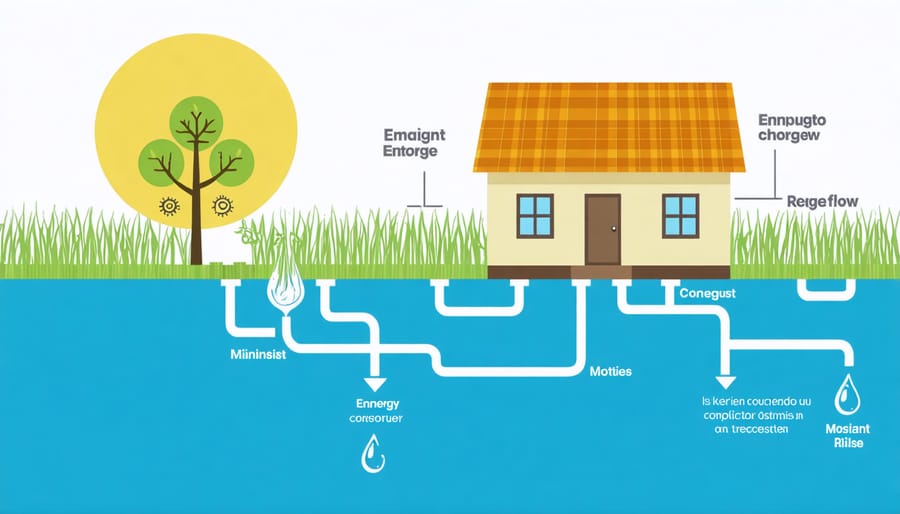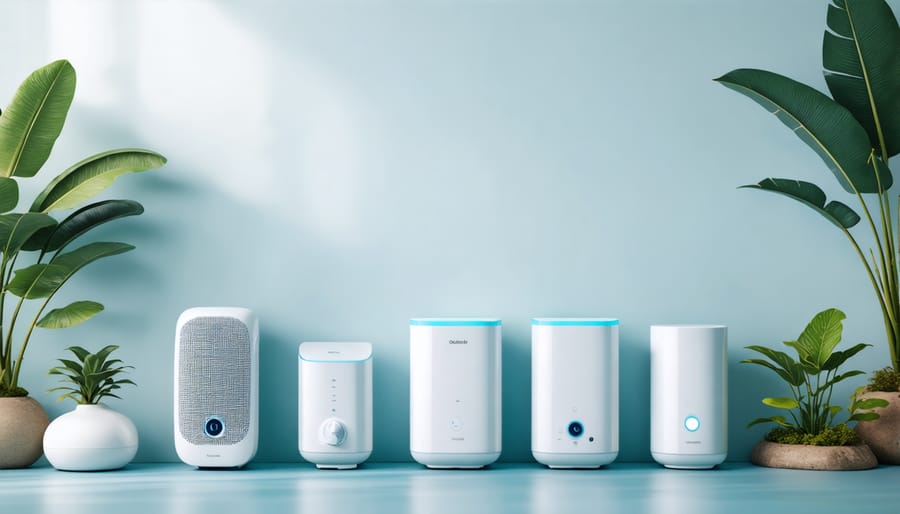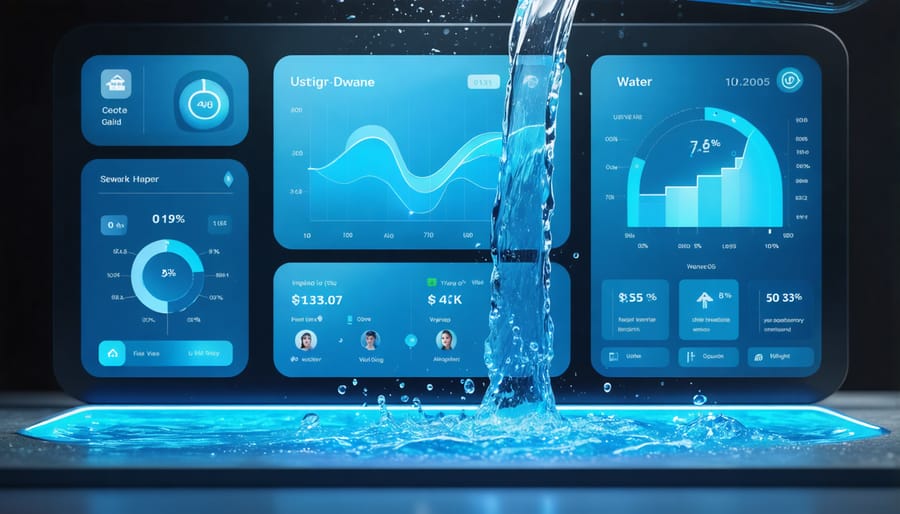Every drop of water flowing through your home carries an energy footprint, from the power needed to heat your morning shower to the electricity driving your dishwasher. This interconnection between water and energy consumption—known as the water-energy nexus—represents one of the most significant opportunities for homeowners to reduce both utility bills and environmental impact. Smart home technology now allows us to monitor and optimize this relationship in real-time, turning data into meaningful savings. By understanding how water and energy work together in your home’s ecosystem, you can make informed decisions that benefit both your wallet and the planet. Modern homes consume about 30% of their energy just heating water, making the water-energy connection a crucial focus for sustainable living. Through smart monitoring systems, efficient appliances, and mindful consumption habits, you can harness the power of the water-energy nexus to create a more sustainable and cost-effective household.
Understanding the Water-Energy Connection in Your Home

Hot Water: Your Biggest Energy Consumer
Did you know that heating water accounts for roughly 18% of your home’s energy use? That’s right – your hot showers, dishwashing, and laundry are likely the biggest energy consumers in your home after heating and cooling.
The average family spends between $400-600 annually just on heating water. But here’s the good news: there are several ways to reduce this energy consumption without sacrificing comfort. Start by checking your water heater’s temperature setting – lowering it from 140°F to 120°F can save you up to 10% on water heating costs while still providing plenty of hot water for your needs.
Simple habits can make a big difference too. Using cold water for laundry, fixing leaky faucets, and taking shorter showers can significantly reduce your hot water usage. For a more substantial impact, consider upgrading to an energy-efficient water heater or installing low-flow fixtures.
Pro tip: Insulating your water heater and the first six feet of hot water pipes can prevent heat loss and reduce your energy consumption by up to 4%.
Hidden Energy Costs in Water Usage
Every time you turn on your faucet, you’re not just using water – you’re also consuming energy, often without realizing it. Your water goes through quite a journey before reaching your home, requiring energy at every step. From the powerful pumps that move water through municipal systems to the treatment plants that make it safe to drink, each process demands significant electrical power.
The hidden energy costs continue right in your home. Your water heater works overtime to keep water hot for showers and dishes, while your washing machine and dishwasher use both water and electricity. Even after you’re done using water, energy is needed to treat and dispose of wastewater through complex sewage systems.
Understanding these connections is crucial for creating zero-energy home solutions. By being mindful of your water usage, you’re not just saving water – you’re reducing your overall energy footprint. Simple changes like fixing leaky faucets or installing low-flow fixtures can make a significant difference in both your water and energy bills.

Smart Technology Solutions for Water-Energy Efficiency
Smart Water Heaters and Temperature Control
Smart water heaters are revolutionizing how we manage our home’s water and energy use. These innovative appliances use advanced sensors and Wi-Fi connectivity to learn your household’s hot water usage patterns and adjust accordingly. Instead of constantly maintaining a high temperature throughout the day, smart water heaters heat water only when needed, significantly reducing energy waste.
By connecting to your smartphone, these systems allow you to monitor and control water temperature remotely. Imagine adjusting your water heater’s settings while you’re at work or receiving alerts if there’s unusual activity or potential maintenance issues. Some models even integrate with other smart home devices, creating a seamless ecosystem that optimizes both water and energy consumption.
The benefits extend beyond convenience. Smart water heaters can cut your energy bills by 10-30% compared to traditional units. They achieve this through features like vacation mode, which automatically lowers temperature when you’re away, and peak-load shifting, which heats water during off-peak hours when electricity rates are lower.
Installation is surprisingly straightforward, with many models designed as direct replacements for conventional water heaters. Some even come with self-diagnostic capabilities, helping you catch potential issues before they become major problems. For maximum efficiency, consider pairing your smart water heater with a whole-home water monitoring system to get a complete picture of your water-energy usage.
Automated Irrigation Systems
Modern automated irrigation systems are revolutionizing how we manage outdoor water use while cutting down on energy consumption. These smart systems use weather data, soil moisture sensors, and intelligent scheduling to deliver exactly the right amount of water your landscape needs – no more, no less.
The magic happens through a combination of smart controllers and precision components. Instead of running on a simple timer, these systems monitor real-time conditions like rainfall, temperature, and soil moisture. When the soil is already wet from rain, the system automatically skips scheduled watering, saving both water and the energy needed for pumping.
Many systems now come with user-friendly smartphone apps that let you control your irrigation from anywhere. You can adjust schedules, monitor water usage, and receive alerts about potential leaks or system issues. Some advanced systems even integrate with local weather forecasts to adjust watering schedules automatically.
The energy savings come from more than just reduced pumping time. By watering at optimal times (typically early morning) and using precise drip irrigation or high-efficiency sprinkler heads, these systems minimize water loss through evaporation. This means less water needs to be pumped overall, resulting in lower energy consumption.
For the best results, consider zoning your yard based on plant types and sun exposure. This allows different areas to receive customized watering schedules, further optimizing both water and energy use.
Smart Appliances and Fixtures
Today’s smart appliances and fixtures are revolutionizing how we manage water and energy in our homes. These innovative devices not only make our lives easier but also help us save money while protecting the environment.
Modern dishwashers now come with eco-settings that use less water while maintaining cleaning effectiveness through precise spray patterns and improved filtration systems. Many models even adjust their water usage based on load size and soil level, ensuring optimal efficiency every time.
Smart washing machines are equally impressive, featuring sensors that determine exactly how much water your clothes need. Some models even recycle rinse water for the next wash cycle, dramatically reducing overall water consumption.
In the bathroom, smart faucets with motion sensors prevent unnecessary running water, while dual-flush toilets give you control over water usage for different needs. Smart showerheads have become game-changers too, offering features like temperature control and water usage tracking through smartphone apps.
The kitchen hasn’t been left behind either. Smart faucets can dispense exact amounts of water for recipes, while leak detection systems alert you to potential problems before they become costly disasters.
These innovations work together to create a more efficient home ecosystem, where every drop of water and unit of energy is used purposefully. The initial investment in these technologies typically pays for itself through reduced utility bills over time.
Real-Time Monitoring and Control
Smart Meters and Usage Tracking
Modern smart meters are revolutionizing how we track and manage our water and energy usage at home. These intelligent devices work together as part of an integrated smart home energy management system, giving you real-time insights into your consumption patterns.
Think of smart meters as your household’s consumption dashboard. For water, they can detect unusual usage patterns, like a running toilet or hidden leak, before they become costly problems. On the energy side, they track electricity usage by appliance and time of day, helping you identify energy-hungry devices and optimal usage times.
The real magic happens when these systems work together. For example, your smart meter might notice that your water heater runs most efficiently during off-peak hours and automatically adjust its schedule. Or it could alert you when your dishwasher’s water usage seems higher than normal, potentially saving you money on both utilities.
Getting started with smart meters is easier than you might think. Many utility companies offer free or subsidized installation programs. Once installed, you can access your usage data through user-friendly smartphone apps or web portals. This visibility helps you make informed decisions about your daily habits and track the impact of your conservation efforts in real dollars and cents.
Mobile Apps and Integration
In today’s digital age, your smartphone can be a powerful ally in managing the water-energy connection in your home. Several user-friendly apps make it easier than ever to monitor and optimize your household’s resource consumption, all from the palm of your hand.
Popular smart home apps like Home Assistant and SmartThings allow you to create automated routines that coordinate your water heater’s operation with your daily schedule. Imagine your water heater automatically adjusting its temperature when you’re away or preparing for your morning shower just when you need it.
Many water utility companies now offer their own apps that provide real-time usage data and leak detection alerts. These apps can notify you immediately if there’s unusual water activity, potentially saving you from costly water damage and wasted energy heating that leaked water.
For those with smart irrigation systems, apps like Rachio and B-hyve help you optimize your garden watering schedule based on weather conditions and soil moisture levels. This prevents overwatering while ensuring your plants get exactly what they need.
Energy monitoring apps like Sense and Emporia Vue can help you identify which appliances are using the most energy for water heating, allowing you to make informed decisions about usage patterns and potential upgrades.
Pro tip: Look for apps that offer integration with your existing smart home devices – this creates a more seamless experience and better coordination between your water and energy systems.

Simple DIY Steps for Better Efficiency
Quick Fixes for Common Water-Energy Waste
Ready to make an immediate impact on your water and energy bills? Let’s dive into some quick fixes that you can implement today. Start in your bathroom by installing a low-flow showerhead – it’s as simple as unscrewing the old one and twisting on the new. This small change can slash your water heating costs by up to 15% while maintaining great shower pressure.
In the kitchen, attach a faucet aerator to reduce water flow without compromising functionality. While you’re there, check under your sink for any dripping pipes – even a small leak can waste hundreds of gallons annually. A quick tightening with a wrench or replacing a worn washer usually does the trick.
Don’t overlook your water heater! Dial it down to 120°F (49°C) – it’s the sweet spot for both safety and efficiency. Wrap your water heater and exposed pipes with insulation sleeves from your local hardware store to prevent heat loss.
For immediate electricity savings, replace your most-used light bulbs with LEDs and seal any drafts around windows and doors with weatherstripping. Consider installing a smart power strip that automatically cuts power to devices in standby mode.
Remember to run your dishwasher and washing machine only when full, and use cold water for laundry when possible. These simple changes require minimal effort but can lead to significant savings on your utility bills.
Maintenance Tips for Optimal Performance
Keeping your water-energy systems running efficiently doesn’t have to be complicated. Regular home system maintenance can make a significant difference in both performance and savings. Here’s what you should do regularly:
Check your water heater settings monthly and adjust them according to seasonal needs. During warmer months, consider lowering the temperature to save energy. Inspect water pipes quarterly for leaks or signs of wear, and ensure proper insulation is maintained, especially in colder areas of your home.
Clean or replace water filters every three months to prevent buildup and maintain optimal flow. This simple step can significantly improve efficiency and reduce energy consumption. For smart water meters and monitoring devices, check the batteries regularly and ensure wireless connections are stable.
Don’t forget about your faucets and showerheads! Remove mineral deposits every six months using vinegar solution to maintain proper flow. This prevents unnecessary pressure on your pumps and helps maintain consistent water temperature.
For homes with water recycling systems, clean the collection tanks twice a year and check all connections. Remember to test smart sensors and calibrate them as needed – they’re your first line of defense against waste and inefficiency.
Set calendar reminders for these maintenance tasks, and you’ll keep your water-energy systems running smoothly while maximizing savings and efficiency.
Understanding the water-energy nexus in our homes empowers us to make smarter, more sustainable choices. By implementing the strategies we’ve discussed, from installing smart meters to fixing leaky faucets, you can significantly reduce both your water and energy consumption. Remember, every drop saved means energy saved, and every efficient choice contributes to both environmental protection and lower utility bills. Start small with simple fixes, then gradually incorporate more advanced solutions as you become comfortable. Your actions matter – not just for your wallet, but for our planet’s future. Take the first step today by choosing one improvement to implement this week, and watch how these small changes add up to meaningful impact over time.
